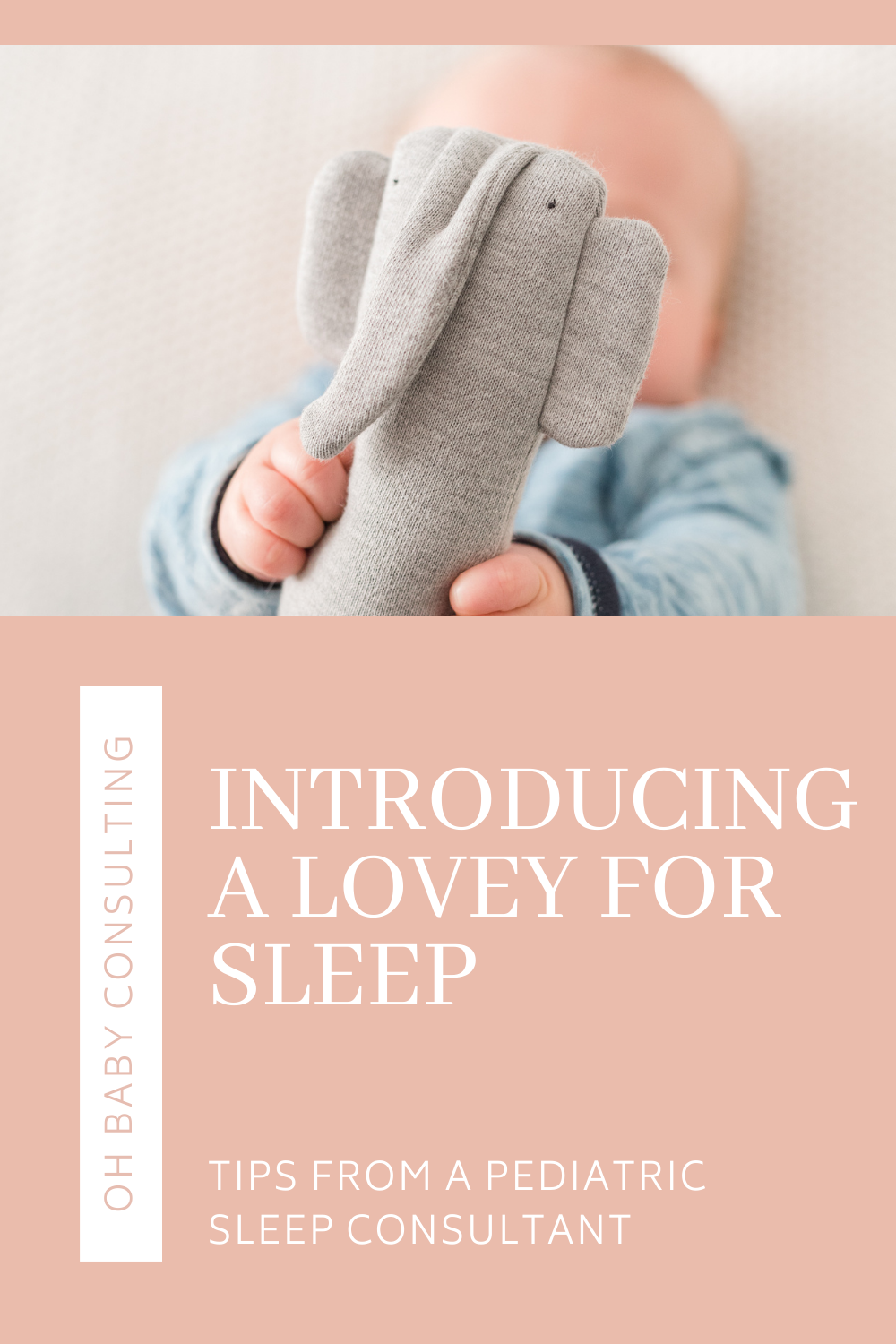Introducing a Lovey
You may be wondering if your child would sleep better or even just would prefer a lovey, stuffed animal, or other comfort item in their crib. But before you introduce a bedtime buddy, here’s what you need to know:
What is a lovey?
A lovey is an object that your child forms an attachment to. Oftentimes loveys help your child feel comforted and soothed. Typically, loveys are stuffed animals, small blankets, or a combination of the two like this.
Are loveys safe for sleep?
At Oh Baby, you know that I take safe sleep very seriously. The American Academy of Pediatrics recommends that nothing extra be in the crib with your child until they are over 12 months. For that reason, my stance is that you wait to introduce a lovey or comfort item to your child at sleep times until after their first birthday. It is fine to introduce a lovey or comfort item before then, just make sure that it goes to its own “bed” when it’s time for your child to sleep.
When is it okay to introduce loveys, blankets, and pillows?
Lovey/small blanket/comfort item:
It is okay to introduce one lovey, small blanket, stuffed animal, or other comfort item for your child to use for sleep once they are 12 months or older.
However, it’s still important to choose your child’s comfort item wisely. Make sure that whatever you choose has no small parts that can be ripped or bitten off and swallowed. This includes sewn on eyes, buttons, or jewels.
You’ll also want to make sure that your child’s lovey is noiseless. There’s nothing worse than crinkling sounds or music waking up your sleeping child in the middle of the night.
And finally, the best loveys are ones that align with your child’s existing self-soothing habits. Observe your child for anything specific they like to do to calm themselves. If your child loves twirling their hair with their fingers, perhaps get them a bunny with long, soft ears that they can play with. If your child goes for tags every time, get a small tag blanket like this. If your child loves rubbing their face, choose a blanket with very soft fabric to avoid irritation.
Blankets:
There is no official age that’s been deemed 100% safe to put a blanket in the crib, but most medical experts feel that a small blanket is appropriate for children 18 months and up as long as they are fully mobile. Chances are, your child is not going to keep a larger blanket on anyway, so unless it’s very important to you, stick with a sleep sack which cannot get kicked off.
If you do introduce a blanket, make sure it is very lightweight, thin, and breathable. Avoid heavy quilts, weighted blankets, or blankets with strings, ties, or ribbons which could be a safety hazard.
Pillows:
The recommendation for a specific age that children can safely use a pillow also varies, but the AAP recommends not introducing a pillow until your child is over the age of 2. I personally don’t think pillows are needed until your child transitions to a bed because they are unnecessary, can pose safety risks, and can be used as leverage for your child to climb out of the crib.
If you do choose to use one when your toddler is still in their crib, make sure it’s small, thin, and firm. Adult pillows are not recommended for toddlers from a safety and neck-support standpoint.
How do I introduce a lovey?
If you’re choosing to give your child a lovey for sleep, understand that some children may simply be uninterested. That’s okay. There is no rule that says you must use a lovey, and I believe that children can still sleep well without one. So set appropriate expectations for yourself first!
One way to help your child attach to a lovey is to make it smell like you! It’s been shown that children up to age 4 prefer their mother’s scent over anyone else’s. To help your child bond with their new lovey, it can be helpful for you to sleep with it or wear it under your shirt during the day for a few days.
You can begin by introducing the lovey during non-sleep times (which can also be done prior to 12 months as well). Offer it during down times, during times of upset, in the car, at the doctor’s office, even during playtime. Incorporating it into your daily routine may help your child attach and actually want to take it to bed with them.
When you first introduce the lovey for sleep times, I recommend starting with bedtime. It is possible that your child may become a little distracted by their new bedtime buddy the first time they’re allowed to bring it into their crib. Because nighttime sleep is easier than daytime sleep, it’s better to preserve the nap as your child gets used to their new sleep friend.
After your bedtime routine (where your child is hopefully holding onto their lovey) you can let them know that they can sleep with their lovey now if they would like. If they don’t’ seem to care, that’s okay. You can keep it in their crib anyway and it’s possible that they will begin to attach over time.
While loveys are certainly not necessary for children to sleep well, they can be a great addition to the sleep environment if you know when and how to introduce one.
If you’re exhausted, totally overwhelmed by your child’s sleep habits, or looking for answers to the sleep questions that keep you up at night (literally), then you’ve come to the right place. I’m Jamie, founder of Oh Baby Consulting, and my goal is to help your family get the sleep you need to not just survive, but thrive!

